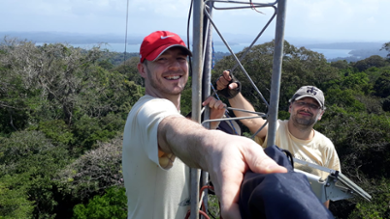
Lianas are taking over the rainforests – and it’s visible from space
A pandemic of lianas is sweeping through tropical forests, reducing their ability to store carbon and limiting their role in mitigating climate change. Two recent studies from Leiden University highlight the issue. ‘We now understand why lianas are visible in satellite imagery.’
Tropical forests annually absorb roughly the amount of CO₂ emitted by the whole of Europe. They also house around half of the world’s biodiversity. However, their contribution to climate regulation and biodiversity is under threat—not only from deforestation but also from an extraordinary surge in lianas. Ecologist Marco Visser from Leiden’s Centre for Environmental Sciences (CML) explains: ‘Lianas can smother and kill trees. When they dominate, the forest becomes choked, and mainly lianas continue growing over fallen trees.’

A liana pandemic for over thirty years
During his doctoral research in 2016, Visser was the first to model lianas as if they were infectious diseases. ‘Lianas—such as passionflowers and numerous other species—can be compared to tapeworms. They intercept trees’ resources and can more than double tree mortality.’ At CML, Visser now supervises PhD candidate Manuela Rueda-Trujillo, who has analysed hundreds of liana studies. Their paper, published last summer, reveals that the increase is not confined to South and Latin America, as previously thought, but is happening wherever tropical forests exist. ‘A liana pandemic has been raging for over thirty years, with their prevalence rising by 10 to 24 percent every decade,’ Visser states.
Lianas benefit more from increased CO₂
Lianas are rapidly expanding their territory in tropical forests, sometimes suppressing tree growth entirely in certain locations. In such areas, forest regeneration halts, and carbon storage can decline by as much as 95 percent. ‘That’s almost equivalent to deforestation’, Visser says. He attributes this to rising atmospheric CO₂ levels. ‘All plants grow faster with more CO₂, but lianas benefit even more. They cheat—they don’t invest in structural support, borrowing it from trees instead, and their leaves require less energy and nutrients to produce.’ A liana can quickly climb to the canopy, spread a leafy cover over tree crowns, and steal all the sunlight for itself.

Lianas can be seen in satellite images
On 28 April Visser published research demonstrating that lianas are visible from space. Collaborating with American and British colleagues, he has now shown why this is the case. Visser developed mathematical models predicting how light interactions occur. ‘Then, we used cranes to access treetops in Panama to measure leaf properties. Our findings confirmed the models were correct.’
Why lianas stand out in satellite imagery
The leaves that make lianas ultra-efficient reflect more light and infrared radiation than tree foliage. They also lie much flatter than tree leaves. ‘Lianas are true egoists,’ Visser explains. ‘Tree leaves tilt, allowing light to reach lower neighbours—even the forest floor gets some sunlight. But lianas leave almost nothing for others.’ These properties make them visible in satellite images. ‘Now that we understand why lianas are detectable from space, we can develop targeted techniques to map their spread and impact worldwide.’
Solution: Stop climate change
Can anything be done about the liana problem? Should we start cutting them down? Definitely not, says Visser. ‘We shouldn't intervene until we fully understand their ecological role. They bear fruit year-round and are vital for rare monkey and bird species.’ The only necessary action, he insists, is halting climate change, which will also slow the expansion of lianas.
